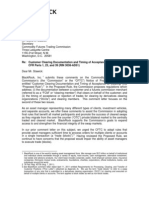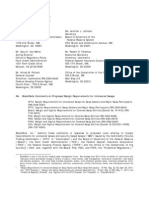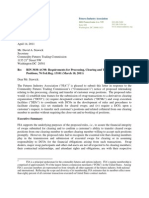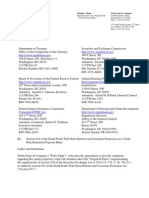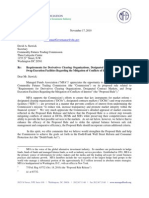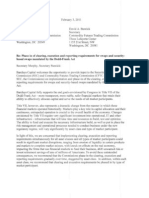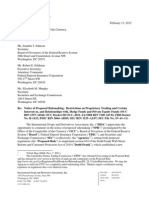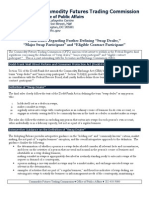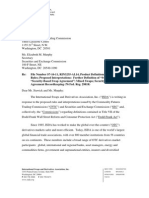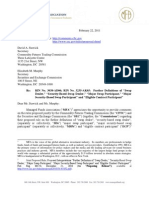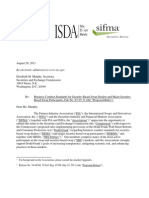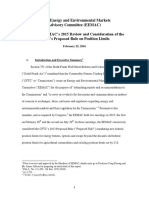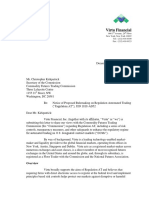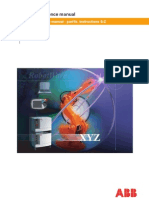Chris Young
Chris Young
Uploaded by
MarketsWikiOriginal Description:
Original Title
Copyright
Available Formats
Share this document
Did you find this document useful?
Is this content inappropriate?
Report this DocumentCopyright:
Available Formats
Chris Young
Chris Young
Uploaded by
MarketsWikiCopyright:
Available Formats
August 8, 2011
David Stawick Secretary Commodity Futures Trading Commission Three Lafayette Centre 1155 21st Street, NW. Washington, DC 20581 Re: RIN No. 3038-AC99 - Notice of Proposed Rulemaking Protection of Cleared Swaps Customer Contracts and Collateral; Conforming Amendments to the Commodity Broker Bankruptcy Provisions (76 Fed. Reg. 33818) Dear Mr. Stawick: The International Swaps and Derivatives Association, Inc. (ISDA) is writing in response to the Notice of Proposed Rulemaking regarding the Protection of Cleared Swaps Customer Contracts and Collateral; Conforming Amendments to the Commodity Broker Bankruptcy Provisions (the NPR) issued by the Commodity Futures Trading Commission (the Commission), seeking comments on proposed rules regarding the treatment of cleared swaps customer contracts (and related collateral). Since 1985, ISDA has worked to make the global over-the-counter (OTC) derivatives markets safer and more efficient. Today, ISDA is one of the worlds largest global financial trade associations, with over 800 member institutions from 56 countries on six continents. These members include a broad range of OTC derivatives market participants: global, international and regional banks, asset managers, energy and commodities firms, government and supranational entities, insurers and diversified financial institutions, corporations, law firms, exchanges, clearinghouses and other service providers. I. Introduction
ISDA agrees with the Commissions selection of the Complete Legal Segregation Model as the most appropriate choice of holding model for cleared swaps collateral. ISDA regards this selection as an important first step in arranging appropriate customer protections against FCM failure. ISDA sees porting as one of the most important of these protections and offers below additional mechanisms in support of porting. We also highlight certain bankruptcy issues that may affect more difficult FCM liquidations and hope to elicit Commission interest in helping to resolve these issues, if not within this rulemaking, then over the longer term.
International Swaps and Derivatives Association, Inc. 1101 Pennsylvania Avenue, Suite 600 Washington, DC 20004 P 202 756 2980 F 202 756 0271
NEW YORK LONDON HONG KONG TOKYO WASHINGTON BRUSSELS SINGAPORE
www.isda.org
ISDA recognizes that there may be a tension between achieving porting and maximizing portfolio-margining, another potent risk-reducing mechanism. ISDA urges the Commission to allow individual customer choice to balance use of these two mechanisms, always with due regard for DCO safety. We note below a variety of issues with rule language and implications, some perhaps inadvertent. Chief among these is the potential to take inadequate account of margin as collateral, and not settlement payments, which could lead to a dislocation of market mechanics and tax treatment. Though we understand why the Commission might be interested in an optional approach to collateral holding models, ISDA suggests that this concept be put aside for now. Optionality will produce complexity and expense that might be tolerable when the cleared swaps market is wellestablished, but that will be burdensome to a developing market. II. A. General Complete Legal Segregation and Porting
ISDA supports the Commissions proposal of the Complete Legal Segregation model as being an appropriate balance of the costs and benefits of the four models proposed in the Commissions Advance Notice of Proposed Rulemaking regarding the Protection of Cleared Swaps Customers Before and After Commodity Broker Bankruptcies (the ANPR). 1 As noted in our second letter to the Commission regarding the ANPR 2 (the Second Comment Letter), ISDA considers the ability of non-defaulting clients of a defaulting futures commission merchant (FCM) to port their positions to be a critical objective of any model for protection of Cleared Swaps Customers, and the Complete Legal Segregation Model is supportive of that objective. We continue to believe that, as noted by the Commission in the NPR, the Legal Segregation with Recourse Model would not likely facilitate post-default 3 portability to the same extent as the Complete Legal Segregation Model, because the derivatives clearing organization (DCO) is unlikely to release the collateral of a defaulted FCMs non-defaulting customers until it has completed the process of liquidating the portfolio of the defaulted FCM and its customers. We would ask the Commission to consider other methods of promoting post-default portability. In our Second Comment Letter, we suggested that non-defaulting clients would need an alternative means of transferring variation margin (VM) to the DCO following their FCMs default until their positions are ported. We referred to this in the Second Comment Letter as use of a backup FCM, which would act as a conduit in passing prefunded VM amounts to the DCO directly. However, since such an entity need not guarantee performance to the DCO, a more accurate description might be a backup settlement agent. The back-up conduit concept needs further discussion and development, but a mechanism of this type is critical. Assuming a time1 2
(75 Fed. Reg. 75162) Letter from ISDA dated February 16, 2011, Re: RIN No. 3038-AD99 - Advanced Notice of Proposed Rulemaking Protection of Cleared Swaps Customers Before and After Commodity Broker Bankruptcies (75 Fed. Reg. 75162) 3 We refer to post-default portability, i.e. porting after the FCM has defaulted, as this is where the ability to port is critical. We do not believe that the ability to port pre-default is affected by the choice of model.
consuming FCM liquidation, a DCO may need to liquidate client positions if it is not receiving VM over time, as may be the case unless there is a conduit for non-defaulting clients to pay in VM post-FCM default. Customers that are concerned about fellow customer risk also may seek to arrange for an actual back-up FCM that would be willing to take their trades and guarantee performance to the DCO. (i.e., act as an FCM). This useful mechanism is yet harder to achieve. Neither the availability of such backup FCM nor portability could be guaranteed in advance due to the need to review the positions to be ported at the time of default. B. Residual Bankruptcy Issues
The default of an FCM with properly maintained finances may be remedied by a rapid bulk transfer of customer accounts (e.g., Refco). A defaulting FCM with inadequate amounts in segregation or irregularities in its accounts, however, may enter into a longer liquidation process. A longer liquidation process may well raise novel issues under Commission rules and the U.S. Bankruptcy Code (the Code). Some examples of such issues are: for cleared swaps that do not qualify as specifically identifiable property under the Commissions Part 190 rules (e.g., a speculative swap), the extent of the trustees duties, as well as the trustees practical ability, to accommodate customer preferences regarding liquidation or transfer of such swap positions, and to provide assurances to prevent their liquidation by the DCO is unclear; the development of contractual mechanisms for implementing customer close-out rights in light of the defaulting FCMs status as agent, rather than principal, in respect of open commodity contracts should be advanced; and issues associated with cross-product netting between commodity contracts and other contracts with, or carried by, the defaulting FCM need exploration. Uncleared swaps have been accorded a degree of certainty in bankruptcy treatment as a result of two decades of specialized Code amendments. See, e,g, 11 U.S.C. 362(b)(17), 546(g), 560. The Dodd-Frank Act moved swaps to a cleared environment and caused cleared swaps to be treated as commodity contracts under the Code, rather than Code swap agreements. See DFA 724(b). In so doing, cleared swaps were separated from the special bankruptcy protections for swap agreements. Ironically, commodity contracts in FCM liquidations face other bankruptcy issues, some of which are listed above. We mention these issues here both to stress the importance of developing improved porting mechanisms and to sensitize the Commission to the need to begin working with market participants to identify and prospectively resolve issues that may interfere with FCM liquidations. The United States, fortunately, has seen only a handful of FCM failures in recent decades. As a result, the FCM liquidation process, including the availability of porting, has not been tested under a wide variety of circumstances. Now that swap clearing must be accomplished through FCMs, rendering the FCM liquidation process certain, including with respect to porting, becomes ever more important. We encourage the Commission to consider in conjunction with market participants mechanisms and rules that would maximize the opportunity for customers that are concerned about fellow customer risk to port their positions to a healthy FCM.
III.
Portfolio-based Margining
ISDA believes effective porting to be of primary importance to cleared swaps customers. Even so, ISDA believes that there may be a rational trade-off to be made between porting and permissible portfolio-based margining. As noted in ISDAs letter to the Commission regarding margin requirements for uncleared swaps for swap dealers and major swap participants, 4 portfolio-based margining across a broad set of products and legal structures is very important, to the extent it can be achieved without reducing the safety of DCOs. Portfolio-based margining allows market participants to efficiently manage their overall risk profile, which will improve market stability and reduce systemic risk. PreDodd-Frank, the swaps markets were able to make significant progress towards portfolio margining with the support of helpful amendments to relevant insolvency law. See, e.g., 11 U.S.C. 561. Dodd-Frank amendments seemingly intended to strengthen the protection for cleared swaps 5 may have diminished the availability of portfolio-based netting. Now, the treatment of cleared swaps collateral should be developed in a way to restore, to the extent not injurious to the clearing system, portfolio based margining. 6 Proposed rule 22.2(d)(1) would prohibit Cleared Swaps Customer Collateral from being used to margin, guarantee, or secure trades or contracts of the entity constituting a Cleared Swaps Customer other than in Cleared Swaps, except to the extent permitted by a Commission rule, regulation or order, or by a derivatives clearing organization rule approved in accordance with 39.15(b)(2) of [the Commissions rules]. Proposed rule 22.2(d)(2) generally forbids imposition of further liens on Cleared Swaps Customer Collateral. These rules as drafted could prevent a customer from obtaining the benefits of portfolio-based margining, even where netting itself is legally enforceable. To the extent that these rules are intended to protect the ability of a customer to port post default, we believe that customers should be able to choose whether to take advantage of portfolio-based margining or whether to maximize the likelihood of post-default portability. Different customers will have different risk tolerances, and each customer should be permitted to adopt the optimal strategy given its risk tolerance, so long as DCO safety is not threatened. Sections 561(b)(2) and (3) of the Bankruptcy Code (the Code), which specifically authorize cross-netting and cross-margining (subject to Commission rule), appear to take a more encouraging view than proposed rule 22.2(d)(1) in the case of a commodity broker debtor. With these statutory provisions in mind, we urge the Commission to acknowledge in rule that
Letter from ISDA and the Securities Industry and Financial Markets Association dated July 11, 2011, Re: Margin requirements for uncleared swaps for swap dealers and major swap participants, available at http://comments.cftc.gov/PublicComments/ViewComment.aspx?id=47802&SearchText. 5 See Dodd-Frank Wall Street Reform and Consumer Protection Act, Pub. L. No. 111-203, 724(b), Stat. 1376 (2010). 6 Please see our comment letter regarding margin for uncleared swaps, supra note 4, at 17-19.
excess collateral may be managed and applied so as to facilitate portfolio-based margining (including to the benefit of uncleared swaps). 7 IV. A. Allowing for VM as Collateral Permitting Proper Collateral Use by DCOs
The proposed definition of Cleared Swaps Customer Collateral includes all money, securities, or other property received by [an FCM or by a DCO] from, for, or on behalf of a Cleared Swaps Customer, which money, securities, or other property . . . [i]s intended to or does margin, guarantee, or secure a Cleared Swap. This definition does not distinguish between IM and VM. VM may take the form of collateral for credit exposure under a swap against the risk of default by a counterparty (as is typically the case for uncleared swaps8) or it may take the form of a settlement payment (as is typically the case for futures), but in either case the movement of funds should be the same a DCO will receive VM from FCMs on behalf of customers whose positions have moved out of the money and will transfer it to FCMs on behalf of customers whose positions have moved in the money. If a DCOs rules provide that VM is collateral rather than settlement payment, then VM could be subject to the proposed definition of Cleared Swaps Customer Collateral. Proposed rule 22.3(a) would require a DCO receiving Cleared Swaps Customer Collateral to treat such collateral as belonging to the Cleared Swaps Customers of the FCM that deposits it and proposed rule 22.3(b) would require a DCO to hold such Cleared Swaps Customer Collateral itself or deposit it at a Permitted Depository. In the case where VM would fall within the definition of Cleared Swaps Customer Collateral, these rules could prevent the DCO from taking any Cleared Swaps Customer Collateral it receives from an FCM and transferring it to an FCM whose customers are on the opposite side of the relevant trades. These rules would seem to require the DCO to hold the posted VM and treat it as belonging to the Cleared Swaps Customers of the FCM that deposits the VM. If so, the DCO would then need to fund separately the VM that must be posted to FCMs on behalf of customers to whom VM is owed. This would be untenable for the existing DCO model. Accordingly, proposed rule 22.3 should be clarified to make it clear that a DCO may transfer collateral posted by an out-of-the-money customer to in-the-money customers. B. Tax Characterization
In the cleared swap context, a variation margin payment may be considered as a settlement paymenta realized profit/lossas in the case of listed futures; or as collateralizing current exposure, a payment representing unrealized profit/loss, as in the case of bilateral (uncleared) swap contracts. If a clearinghouse treats swap variation margin as a contract settlement (as is the case with futures) then, to the extent that such treatment is applied to swap customers of clearing members, these customers will be limited to a mark-to-market tax regime, paying ordinary income rates on swap returns.
7 8
Id., p.20 Use of security agreements far outweighs use of transfer annexes or coupon resets in the U.S. market.
Such tax treatment will affect many financial end users, particularly those using swaps to hedge assets and those using swaps to obtain exposure to an asset class. For example, in the uncleared swap context, for a bond portfolio hedged with interest rate swaps (where variation margin would collateralize the trade exposure) the realized coupon income on the swaps is netted with the income on the bonds, and, for tax purposes, the two are considered together. It is only when the bond or swap is sold or terminated, that long or short-term capital gains or losses are taxed as settlement. If variation margin is treated by the clearinghouse as settlement, asset managers and many other financial end users may have to mark-to-market their contracts daily for tax purposes. This would reduce the effectiveness of swap hedging, would reduce post tax returns to many users, would generally reduce user interest in the swap markets, and would reduce the liquidity of the swap markets. Moreover, we believe that Congress did not intend to change the typical tax treatment of swaps. While futures receive a split 60/40 tax treatment under section 1256 of the Internal Revenue Code (i.e., 60% long-term capital gains, 40% short-term capital gains), under Dodd-Frank, cleared swaps are exempted from being treated as section 1256 contracts. 9 Accordingly, we request that the Commission clarify that DCOs will be allowed to treat variation margin as collateral, rather than settlement. Without such clarification, DCOs may interpret proposed rule 22.3 in such a way as to prohibit treating customer variation margin as collateral. Such DCOs would not be able to pass customer variation losses to counterparties that have corresponding gains on cleared contracts. V. Investment Returns on Cleared Swaps Customer Collateral
The provisions of the proposed rules relating to the investment return on assets representing Cleared Swaps Customer Collateral should be clarified. The proposed definition of Cleared Swaps Customer Collateral includes accruals, i.e., all money, securities, or other property that a futures commission merchant or derivatives clearing organization receives, directly or indirectly, which is incident to or results from a Cleared Swap that a futures commission merchant intermediates for a Cleared Swaps Customer. Although this language refers to money, securities or other property resulting from a Cleared Swap (as opposed to resulting from Cleared Swaps Customer Collateral), the inclusion of the words incident to widens the scope beyond those accruals resulting specifically from trades. In addition, the commentary in the NPR on this point says that any increases in value resulting from the investment [of Cleared Swaps Customer Collateral] would properly belong to the Cleared Swaps Customer, and would constitute another form of Cleared Swaps Customer Collateral. 76 F.R. 33831-82. If this commentary should be read to indicate that investment returns must belong to Cleared Swaps Customers without giving the parties the freedom to agree how to allocate investment returns, then this would be flatly inconsistent with proposed rule 22.10, specifically the incorporation by reference of rule 1.29, which would permit FCMs and DCOs investing Cleared
See Dodd-Frank Wall Street Reform and Consumer Protection Act, Pub. L. No. 111-203, 1601(a)(2), Stat. 1376 (2010).
9
Swaps Customer Collateral to receive and retain any increment or interest thereon. It would also be inconsistent with proposed rule 22.2(f)(2)(ii), which refers to [a]ny accruals or losses on permitted investments of [Cleared Swaps Customer Collateral] . . . that, pursuant to the futures commission merchants customer agreement with that customer, are creditable or chargeable to such customer. (Emphasis added). Because of the specific incorporation by reference of rule 1.29 for Cleared Swaps and the reference to the FCMs agreement with the customer in allocating accruals or losses on permitted investments, we do not believe that it was the Commissions intention to change longstanding practice for futures contracts, where customers, FCMs and DCOs are free to agree how to allocate investment returns on customer funds. This is particularly so since the combination of the commingling and investment powers contemplated by the proposed rules would make it impossible in practice to identify the investment return resulting from the Cleared Swaps Customer Collateral posted by any particular Cleared Swaps Customer. We therefore suggest that the definition of Cleared Swaps Customer Collateral and the relevant commentary in the NPR be clarified in the final rules to make clear that investment returns only constitute Cleared Swaps Customer Collateral to the extent that the FCM or DCO has agreed to pay a rate of return or other investment returns to a Cleared Swaps Customer. VI. Cleared Swaps Customer Collateral Held Outside the United States
The swaps markets are global, with transactions and collateral denominated in a wide range of currencies. Where a Cleared Swap or Cleared Swaps Customer Collateral is denominated in a currency other than United States dollars (USD), it is likely that such Cleared Swaps Customer Collateral will need to be held outside the United States. The rules on currencies of denomination of, and permitted locations for, Cleared Swaps Customer Collateral are therefore important to consider. Proposed rule 22.9 would incorporate by reference rule 1.49, which specifies for futures the circumstances in which customer funds may be denominated in currencies other than USD and/or held outside the United States. Rule 1.49(b)(1), as amended by proposed rule 22.9, would require an FCMs obligations to a Cleared Swaps Customer to be denominated in (i) USD, (ii) in a currency in which funds were deposited by the customer or were converted at the request of the customer, to the extent of such deposits and conversions, or (iii) in a currency in which funds have accrued to the customer as a result of trading conducted on a designated contract market or registered derivatives transaction execution facility, to the extent of such accruals. Under rule 1.49(c) (as amended by proposed rule 22.9), an FCM or DCO could hold Cleared Swaps Customer Collateral outside the United States in a money center country (Canada, France, Italy, Germany, Japan, and the United Kingdom) or the country of origin of the currency. Cleared Swaps Customer Collateral could only be held in any other country to the extent authorized by the Cleared Swaps Customer (a written record of such authorization is also required). An FCM or DCO would be required to hold sufficient USD in the United States to meet all USD-denominated Cleared Swaps obligations. For Cleared Swaps obligations denominated in any other currency, an FCM or DCO would be required to hold sufficient funds 7
denominated in USD, money center currencies (the currency of any money center country and the Euro) or the currency in which the relevant Cleared Swaps obligation is denominated, and for such purpose USD or money center currencies may be held in the United States or in any money center country. If an FCM or DCO were to hold Cleared Swaps Customer Collateral outside the United States as permitted above, then the Cleared Swaps Customer Collateral would need to be deposited with an FCM registered with the Commission (but only if such FCM is acting as a Collecting FCM), a DCO or a bank or trust company that has in excess of $1 billion of regulatory capital. In addition, the depository would need to provide the FCM or DCO with the appropriate written acknowledgement as required under rules 1.20 and 1.26 (i.e., that the depository was informed that the funds or instruments deposited belong to commodity or option customers and are being held in accordance with the provisions of the Act and part 1 of the Commissions rules). 10 We would make several observations on the above rules. First, romanette (iii) of rule 1.49(b)(1) should be expanded to reflect the wider scope of execution methods available for Cleared Swaps, otherwise Cleared Swaps Customer Collateral for Cleared Swaps denominated in a currency other than USD would be required to be held in USD in the United States if the Cleared Swap were not traded on a designated contract market. Second, rule 1.49 should be amended to make plain that "depositories" includes those of a type able to provide appropriate securities accounts for securities collateral. Third, the requirement that a foreign depository provide the FCM or DCO with a letter that the funds or instruments deposited are held in accordance with the provisions of the Act would not avoid the fact that the foreign depository would be subject to its local bankruptcy jurisdiction, the rules of which may differ significantly from the U.S. Bankruptcy Code. In truth, the described letter may be difficult to get and of little purpose, if obtained. VII. Clarifications
It would be helpful to make the following clarifications in the proposed rules. Residual Interest Proposed rule 22.2(e)(4)(ii) may be read to suggest (due to ambiguous use of the word such) that an FCM would have a residual interest only in any money, securities, or other property that a futures commission merchant places in an FCM Physical Location or deposits in a Cleared Swaps Customer Account. This could imply that if an FCM has not deposited its own property in a particular Cleared Swaps Customer Account, then a residual balance in that Cleared Swaps
Proposed rule 22.9 provides that the provisions of rule 1.49 apply to Cleared Swaps Customer Collateral as if it comprised customer funds subject to segregation pursuant to section 4d(a) of the Act. This is different from the approach adopted in proposed rule 22.5, which specifically modifies rules 1.20 and 1.26 so that references to customer funds apply to Cleared Swaps Customer Collateral, and references to section 4d(a) or 4d(b) of the Act and the regulations thereunder apply to section 4d(f) of the Act and the regulations thereunder. It would be helpful to clarify whether any difference in outcome is intended by this difference in drafting.
10
Customer Account is not part of the FCMs residual interest. We believe that clause (ii) is intended to refer to a residual financial interest in all property in excess of that subject to the clause (f)(4) segregation requirement. We urge the Commission to clarify both this point and the point that the concept of residual financial interest is not hived into separate customer and collateral type components. For example, if a customer deposits $80 of securities and $20 of cash, the FCM deposits an additional $80 of its own funds in the cash account and then $100 is returned from the cash account to the customer, the FCM should have a residual interest in the securities account even though it has not deposited any of its own securities in that account. It should be clarified that the residual interest exists across all of an FCMs Cleared Swaps Customer Accounts, regardless of the amount the FCM has specifically contributed to each such account individually. Short-term Unsecured Customer Loans Proposed rule 22.10 would apply existing section 1.30 of the Commissions rules to cleared swaps. Section 1.30 states that FCMs may lend their own funds to customers on securities and property pledged by such customers. We understand that this permissively stated provision does not implicitly forbid FCMs in the futures markets from the practice of advancing collateral to DCOs on behalf of FCM customers prior to receiving reimbursement or collateral for such advances. However, in its commentary on proposed rule 22.12, the Commission states that where a customer has posted insufficient collateral with its FCM, then the FCM will have made a loan to the customer. We urge the Commission to make clear that this practice of advancing funds to a DCO on behalf of a customer, intended to assure the requisite and timely flow of collateral to DCOs, will also be recognized with respect to cleared swaps. If an FCM were required to treat such advances as a loan under section 1.30, then FCMs would need to have clients prefund their margin. Identification of Cleared Swaps Customers Proposed rule 22.11 would require that the first time that the Depositing Futures Commission Merchant intermediates a Cleared Swap for a Cleared Swaps Customer, it must provide information sufficient to identify such customer. This could be further clarified by specifying that the first time referred to is the first time the FCM intermediates a Cleared Swap for a particular Cleared Swaps Customer with the relevant DCO or Collecting FCM, rather than the first time the FCM intermediates a Cleared Swap with any DCO or Collecting FCM. Use of Residual Interest to Margin Cleared Swaps Proposed rule 22.13(b) provides that where a DCO or Collecting FCM requires a particular Cleared Swaps Customer or a group of Cleared Swaps Customers to post additional collateral, it may use the relevant FCMs or Depositing FCMs own funds deposited in the Cleared Swaps Customer Account (or held in an FCM Physical Location) to margin the cleared swaps of any or all of such Cleared Swaps Customers (to the extent of the FCM or Depositing FCMs residual financial interest). This rule does not however specify how such amounts should be attributed to individual Cleared Swaps Customers. It is necessary to attribute amounts held in an omnibus account to individual Cleared Swaps Customers in order to determine which Cleared Swaps 9
Customers have a credit balance and which have a debit balance, as provided in proposed rule 22.2(f). VIII. Optionality
While the optional approach may merit consideration when the market is better developed, ISDA believes that optionality should not be considered now. Implementing optionality at this time would likely dramatically increase the already substantial start-up expenses being faced by the cleared-swaps marketplace. Accordingly, the Commission should delay consideration of the optional approach, and should revisit the issue only following the successful implementation of the Complete Legal Segregation Model. ISDA agrees with the Commissions assessment in the NPR of the difficulties of reconciling the optional approach with the requirements of the Bankruptcy Code and Part 190 of the Commissions rules. The Commission sets out a possible workaround to these difficulties, which would be to require FCMs to establish two legal entities, each of which is limited to clearing at DCOs that use only one of (A) the Complete Legal Segregation Model or (B) the Legal Segregation with Recourse Model, and requests comment on the practicability of this approach. ISDA would have substantial doubts about the practicality of a requirement that FCMs establish separate legal entities for different DCOs offering different customer segregation models. To explain why, we think it is helpful to set out our understanding of how such a system would operate. By assumption, different DCOs would select either the Complete Legal Segregation Model or the Legal Segregation with Recourse Model. Once made, that choice would presumably be binding for a DCO. A customer would then have the option to select with which DCO to clear (assuming more than one DCO accepts the relevant contract for clearing). Once the customer has selected the DCO to clear the contract, the customers FCM will then need to assign the contract to the relevant FCM legal entity, depending on the model used by the DCO. It should be noted that the customer is not presented with a simple choice as to the model of customer collateral protection it prefers. Instead, it must choose a DCO. Customers already have a choice of DCOs for several types of contract, and may take account of many factors in deciding which DCO to clear with. As a result, the choice of model of customer collateral protection would be only one factor among many others in choosing a DCO. For the customer to have any option at all, the relevant contract would need to be offered by two or more DCOs that have adopted different customer collateral protection models. As a result, we believe that this model would only provide valuable optionality in the limited cases where two otherwise very similar DCOs offer the same contract for clearing and have adopted different customer collateral protection models. Due to the network effects inherent in clearing, a proliferation of successful DCOs using different customer collateral protection models does not appear to be a likely nor necessarily a desirable outcome. In addition, the requirement on FCMs to establish separate legal entities would involve additional costs that would be borne by the industry as a whole. These extra costs would arise due to initial 10
setup costs and the reductions in efficiency of having two separate operations at each FCM (consider separate compliance and capital demands, for example). The requirement of separate legal entities could also negatively impact the availability of legally enforceable netting, which as noted above is a pre-requisite for portfolio-based margining. Another aspect of the proposed optional model is the risk that it may provide an incentive to choose the less expensive model during times of low credit risk, but to move contracts to DCOs with a higher level of customer collateral protection during periods of credit stress. The resulting changes in collateral requirements would be pro-cyclical, potentially reducing the collateral in the financial system during periods of economic stability and exacerbating periods of stress. IX. Effective Date
The Commission requests comment on the appropriateness of the effectiveness of the proposed rules six months after promulgation in final form. There will be substantial policy, procedure and infrastructure developments that will need to be tailored to choices made in the final rules. We believe that these developments need to be not only done, but must be given enough time to be done carefully so as to achieve the goals of the proposed rule and avoid any unintended consequences. We recommend a minimum of 18 months between final promulgation and effectiveness. * * *
ISDA looks forward to working with the Commission as you continue the rulemaking process. Please feel free to contact me or my staff at your convenience. Sincerely,
Robert Pickel Executive Vice Chairman
11
You might also like
- Spurious InfinitiesDocument71 pagesSpurious InfinitiesANONYMUSSSSSSSSNo ratings yet
- The FutureDocument8 pagesThe FutureTrang Choi ChoiNo ratings yet
- I. Summary of CommentsDocument5 pagesI. Summary of CommentsMarketsWikiNo ratings yet
- Joanne MederoDocument9 pagesJoanne MederoMarketsWikiNo ratings yet
- Black RockDocument7 pagesBlack RockMarketsWikiNo ratings yet
- Re: Blackrock Comments On Proposed Margin Requirements For Uncleared SwapsDocument5 pagesRe: Blackrock Comments On Proposed Margin Requirements For Uncleared SwapsMarketsWikiNo ratings yet
- Karrie McmillanDocument9 pagesKarrie McmillanMarketsWikiNo ratings yet
- Tara HairstonDocument6 pagesTara HairstonMarketsWikiNo ratings yet
- IsdaDocument13 pagesIsdaMarketsWikiNo ratings yet
- C A S G F C R M: Ommittee On GricultureDocument12 pagesC A S G F C R M: Ommittee On GricultureJohn J. LothianNo ratings yet
- Jiri KrolDocument5 pagesJiri KrolMarketsWikiNo ratings yet
- Marcus StanleyDocument11 pagesMarcus StanleyMarketsWikiNo ratings yet
- Submitted Via Agency WebsiteDocument7 pagesSubmitted Via Agency WebsiteMarketsWikiNo ratings yet
- Via Agency Website: Re: End-User Clearing Exception / File Number RIN 3038-AD10Document13 pagesVia Agency Website: Re: End-User Clearing Exception / File Number RIN 3038-AD10MarketsWikiNo ratings yet
- By Electronic SubmissionDocument38 pagesBy Electronic SubmissionMarketsWikiNo ratings yet
- Dealers") For Their Dealing Activities in Swaps and Security-Based Swaps (Collectively, "Swaps")Document6 pagesDealers") For Their Dealing Activities in Swaps and Security-Based Swaps (Collectively, "Swaps")MarketsWikiNo ratings yet
- Investment Company InstituteDocument10 pagesInvestment Company InstituteMarketsWikiNo ratings yet
- Via Electronic Submission:: After Commodity Broker Bankruptcies (The "ANOPR")Document10 pagesVia Electronic Submission:: After Commodity Broker Bankruptcies (The "ANOPR")MarketsWikiNo ratings yet
- Michael BoppDocument4 pagesMichael BoppMarketsWikiNo ratings yet
- Defs QaDocument3 pagesDefs QaMarketsWikiNo ratings yet
- Dodd-Frank Essentials For End Users of Otc Derivatives - Update 6Document4 pagesDodd-Frank Essentials For End Users of Otc Derivatives - Update 6LameuneNo ratings yet
- 77 FR 21278 - Customer Clearing Documentation, Timing of Acceptance For Clearing, and Clearing Member Risk ManagementDocument33 pages77 FR 21278 - Customer Clearing Documentation, Timing of Acceptance For Clearing, and Clearing Member Risk ManagementIQ3 Solutions GroupNo ratings yet
- Metlife 3Document5 pagesMetlife 3MarketsWikiNo ratings yet
- AIMA Comment Letter On Dec 23, 2010 - Swaps For Mandatory ClearingDocument4 pagesAIMA Comment Letter On Dec 23, 2010 - Swaps For Mandatory ClearingMarketsWikiNo ratings yet
- MFA3Document8 pagesMFA3MarketsWikiNo ratings yet
- Barbara Wier Zy N SkiDocument9 pagesBarbara Wier Zy N SkiMarketsWikiNo ratings yet
- Via Electronic SubmissionDocument8 pagesVia Electronic SubmissionMarketsWikiNo ratings yet
- By Commission Website: Futures Industry AssociationDocument6 pagesBy Commission Website: Futures Industry AssociationMarketsWikiNo ratings yet
- Capital, Margin, and Segregation Requirements For Security-Based Swap Dealers and Major Security-Based Swap Participants and Capital Requirements For Broker-Dealers (File No. S7-08 12)Document12 pagesCapital, Margin, and Segregation Requirements For Security-Based Swap Dealers and Major Security-Based Swap Participants and Capital Requirements For Broker-Dealers (File No. S7-08 12)MarketsWikiNo ratings yet
- Morgan Stanley Regarding Proposed Rules Relating To Definitions Contained in Title VII of Dodd-Frank Wall Street Reform and Consumer Protection ActDocument10 pagesMorgan Stanley Regarding Proposed Rules Relating To Definitions Contained in Title VII of Dodd-Frank Wall Street Reform and Consumer Protection ActMarketsWikiNo ratings yet
- Via Electronic Mail: Chief Executive OfficerDocument5 pagesVia Electronic Mail: Chief Executive OfficerMarketsWikiNo ratings yet
- U.S. Commodity Futures Trading Commission: Etter O Dvisories CtoberDocument6 pagesU.S. Commodity Futures Trading Commission: Etter O Dvisories CtoberMichaelPatrickMcSweeneyNo ratings yet
- Michael BoppDocument6 pagesMichael BoppMarketsWikiNo ratings yet
- Timothy J. Sloan Wells Fargo & CompanyDocument39 pagesTimothy J. Sloan Wells Fargo & CompanyMarketsWikiNo ratings yet
- Requirements For Processing, Clearing, and Transfer of Customer PositionsDocument4 pagesRequirements For Processing, Clearing, and Transfer of Customer PositionsMarketsWikiNo ratings yet
- Via Electronic Mail:: Dcodcmsefgovernance@Cftc - GovDocument6 pagesVia Electronic Mail:: Dcodcmsefgovernance@Cftc - GovMarketsWikiNo ratings yet
- Morgan Stanley: Necessity of Phase ApproachDocument9 pagesMorgan Stanley: Necessity of Phase ApproachMarketsWikiNo ratings yet
- CME Group: ElizabethDocument7 pagesCME Group: ElizabethMarketsWikiNo ratings yet
- Re: RIN 3038-AD99: Protection of Cleared Swaps Customers Before and After Commodity Broker Bankruptcies 75 Fed - Reg. 75162 (December 2, 2010)Document9 pagesRe: RIN 3038-AD99: Protection of Cleared Swaps Customers Before and After Commodity Broker Bankruptcies 75 Fed - Reg. 75162 (December 2, 2010)MarketsWikiNo ratings yet
- Via Electronic Submission:: Rule-Comments@sec - GovDocument6 pagesVia Electronic Submission:: Rule-Comments@sec - GovMarketsWikiNo ratings yet
- Sifma: Invested AmericaDocument9 pagesSifma: Invested AmericaMarketsWikiNo ratings yet
- Stuart KaswellDocument12 pagesStuart KaswellMarketsWikiNo ratings yet
- Advanced Notice of Proposed Rulemaking Relating To Protection of Cleared Swaps Customers Before and After Commodity Broker BankruptciesDocument13 pagesAdvanced Notice of Proposed Rulemaking Relating To Protection of Cleared Swaps Customers Before and After Commodity Broker BankruptciesMarketsWikiNo ratings yet
- Co, A S: I UturDocument5 pagesCo, A S: I UturMarketsWikiNo ratings yet
- Swap ParticipantsDocument6 pagesSwap ParticipantsMarketsWikiNo ratings yet
- William HenleyDocument3 pagesWilliam HenleyMarketsWikiNo ratings yet
- International Swaps and Derivatives Association, IncDocument24 pagesInternational Swaps and Derivatives Association, IncMarketsWikiNo ratings yet
- Mandatory Clearing of Security-Based Swaps, End-User Exception and Security-Based Swap Clearing AgenciesDocument5 pagesMandatory Clearing of Security-Based Swaps, End-User Exception and Security-Based Swap Clearing AgenciesMarketsWikiNo ratings yet
- Deutsche Bank: Consistent RulemakingDocument14 pagesDeutsche Bank: Consistent RulemakingMarketsWikiNo ratings yet
- Black RockDocument4 pagesBlack RockMarketsWikiNo ratings yet
- MSP Ecp Factsheet FinalDocument7 pagesMSP Ecp Factsheet FinalMarketsWikiNo ratings yet
- Chris YoungDocument18 pagesChris YoungMarketsWikiNo ratings yet
- Via Electronic Submission:: Release")Document16 pagesVia Electronic Submission:: Release")MarketsWikiNo ratings yet
- Rich WhitingDocument4 pagesRich WhitingMarketsWikiNo ratings yet
- International Swaps and Derivatives Association, IncDocument73 pagesInternational Swaps and Derivatives Association, IncMarketsWikiNo ratings yet
- Isda and FiaDocument7 pagesIsda and FiaMarketsWikiNo ratings yet
- Re: File No. S7-06-11 - Registration and Regulation of Security-Based Swap Execution Facilities (76 Fed. Reg. 10948)Document13 pagesRe: File No. S7-06-11 - Registration and Regulation of Security-Based Swap Execution Facilities (76 Fed. Reg. 10948)MarketsWikiNo ratings yet
- Via Electronic Submission To: Comments@Sec - Gov: With A Copy ToDocument10 pagesVia Electronic Submission To: Comments@Sec - Gov: With A Copy ToMarketsWikiNo ratings yet
- By Electronic Submission To WWW - Sec.govDocument30 pagesBy Electronic Submission To WWW - Sec.govMarketsWikiNo ratings yet
- SB FactsheetDocument2 pagesSB FactsheetMarketsWikiNo ratings yet
- Determination"), That Swap Must Be Executed On A SEF or DCM, Unless Another Exemption Applies. WeDocument6 pagesDetermination"), That Swap Must Be Executed On A SEF or DCM, Unless Another Exemption Applies. WeMarketsWikiNo ratings yet
- Summary of Stefan Loesch's A Guide to Financial Regulation for Fintech EntrepreneursFrom EverandSummary of Stefan Loesch's A Guide to Financial Regulation for Fintech EntrepreneursNo ratings yet
- Minute Entry 336Document1 pageMinute Entry 336MarketsWikiNo ratings yet
- Federal Register / Vol. 81, No. 88 / Friday, May 6, 2016 / Rules and RegulationsDocument6 pagesFederal Register / Vol. 81, No. 88 / Friday, May 6, 2016 / Rules and RegulationsMarketsWikiNo ratings yet
- CFTC Final RuleDocument52 pagesCFTC Final RuleMarketsWikiNo ratings yet
- Eemac022516 EemacreportDocument14 pagesEemac022516 EemacreportMarketsWikiNo ratings yet
- 34 77617 PDFDocument783 pages34 77617 PDFMarketsWikiNo ratings yet
- Federal Register / Vol. 81, No. 55 / Tuesday, March 22, 2016 / NoticesDocument13 pagesFederal Register / Vol. 81, No. 55 / Tuesday, March 22, 2016 / NoticesMarketsWikiNo ratings yet
- Douglas C I FuDocument4 pagesDouglas C I FuMarketsWikiNo ratings yet
- Commodity Futures Trading Commission: Office of Public AffairsDocument2 pagesCommodity Futures Trading Commission: Office of Public AffairsMarketsWikiNo ratings yet
- Via Electronic Submission: Modern Markets Initiative 545 Madison Avenue New York, NY 10022 (646) 536-7400Document7 pagesVia Electronic Submission: Modern Markets Initiative 545 Madison Avenue New York, NY 10022 (646) 536-7400MarketsWikiNo ratings yet
- Commodity Futures Trading Commission: Vol. 80 Wednesday, No. 246 December 23, 2015Document26 pagesCommodity Futures Trading Commission: Vol. 80 Wednesday, No. 246 December 23, 2015MarketsWikiNo ratings yet
- Commodity Futures Trading Commission: Office of Public AffairsDocument3 pagesCommodity Futures Trading Commission: Office of Public AffairsMarketsWikiNo ratings yet
- 2015-10-22 Notice Dis A FR Final-RuleDocument281 pages2015-10-22 Notice Dis A FR Final-RuleMarketsWikiNo ratings yet
- Daniel Deli, Paul Hanouna, Christof W. Stahel, Yue Tang and William YostDocument97 pagesDaniel Deli, Paul Hanouna, Christof W. Stahel, Yue Tang and William YostMarketsWikiNo ratings yet
- Commodity Futures Trading Commission: Office of Public AffairsDocument5 pagesCommodity Futures Trading Commission: Office of Public AffairsMarketsWikiNo ratings yet
- Commodity Futures Trading Commission: Office of Public AffairsDocument2 pagesCommodity Futures Trading Commission: Office of Public AffairsMarketsWikiNo ratings yet
- 34 76474 PDFDocument584 pages34 76474 PDFMarketsWikiNo ratings yet
- Odrgreportg20 1115Document10 pagesOdrgreportg20 1115MarketsWikiNo ratings yet
- Americell Exhibit A 47 C.F.R. 64.2009 Compliance Certificate 2015 For 2014Document2 pagesAmericell Exhibit A 47 C.F.R. 64.2009 Compliance Certificate 2015 For 2014Federal Communications Commission (FCC)No ratings yet
- Advance BNK Management - Credit PDFDocument2 pagesAdvance BNK Management - Credit PDFPratheesh TulsiNo ratings yet
- The Chief Goal of Wisdom Is A Fundamental Understanding of Reality As It Relates To Living A Good LifeDocument10 pagesThe Chief Goal of Wisdom Is A Fundamental Understanding of Reality As It Relates To Living A Good LifeCerisse RemoNo ratings yet
- (PDF Download) How To Pass Exams Second Edition Fred Orr Fulll ChapterDocument24 pages(PDF Download) How To Pass Exams Second Edition Fred Orr Fulll Chapterintzamcaylor100% (2)
- National Pension System (NPS) - Subscriber Registration FormDocument12 pagesNational Pension System (NPS) - Subscriber Registration FormPascal ChhakchhuakNo ratings yet
- Retrofitting of RC Structure Using FRP Laminate: AbstractDocument10 pagesRetrofitting of RC Structure Using FRP Laminate: AbstractYo Yo AkNo ratings yet
- Potter Waltz ViolaDocument1 pagePotter Waltz ViolaOndrej PuškárNo ratings yet
- Bar Council RulesDocument139 pagesBar Council RulesMeow All100% (1)
- Manual TDM Uk Rev08Document16 pagesManual TDM Uk Rev08myohotosdataNo ratings yet
- Menu & Produk Rumah Sarwono 2023Document25 pagesMenu & Produk Rumah Sarwono 2023dwipujiastutiNo ratings yet
- Mini ProjectDocument15 pagesMini ProjectRevanth Local MokkapatiNo ratings yet
- 2 Fast 2 Furious AnalysisDocument5 pages2 Fast 2 Furious AnalysisKhalidNo ratings yet
- IRC5-Rapid Reference Part1B 3HAC16581-1 RevB en Part1b LibraryDocument380 pagesIRC5-Rapid Reference Part1B 3HAC16581-1 RevB en Part1b Librarymauro_ricardo_sNo ratings yet
- A GENERAL PHYSICS I 12 Q2M2 Teacher PDFDocument17 pagesA GENERAL PHYSICS I 12 Q2M2 Teacher PDFRETCHIE JOY PISANANo ratings yet
- The Fractal Dimension of The Lorenz Attractor lp2Document5 pagesThe Fractal Dimension of The Lorenz Attractor lp2rohitNo ratings yet
- Sculpting Stylized ChraractersDocument41 pagesSculpting Stylized ChraractersNikhilesh Thatipamula100% (1)
- 2024 Honda CR-V Specifications - enDocument3 pages2024 Honda CR-V Specifications - enAhmed GaballaNo ratings yet
- Business Accounting Course Outline 2021Document7 pagesBusiness Accounting Course Outline 2021Everjoice Chatora100% (1)
- Basics of The 4-1-4-1 Formation: SetupDocument9 pagesBasics of The 4-1-4-1 Formation: SetupNAYIM OZNAIMNo ratings yet
- A1 Beauty and The BeastDocument82 pagesA1 Beauty and The BeastDulfary VallejoNo ratings yet
- Assignment 2 - Periods of Literature in The PhilippinesDocument2 pagesAssignment 2 - Periods of Literature in The PhilippinesHazel Solis100% (1)
- Recruitment Fiasco at CITPR Ltd. - CASE STUDYDocument5 pagesRecruitment Fiasco at CITPR Ltd. - CASE STUDYPRAGYA SINGH-DM 21DM137No ratings yet
- Jarin Tasnim Muna (MIS)Document68 pagesJarin Tasnim Muna (MIS)NabilNo ratings yet
- 04 Uic - Plane Geometry - 2017 KeyDocument5 pages04 Uic - Plane Geometry - 2017 KeyJazyl PeralesNo ratings yet
- Reducing The Global Burden of Cardiovascular Disease,: ReviewDocument18 pagesReducing The Global Burden of Cardiovascular Disease,: Reviewmanuel pimentel del campoNo ratings yet
- Vragen VACBI A330-200 ATA 21Document7 pagesVragen VACBI A330-200 ATA 21Arkadiy Chernov100% (1)
- Brad Pitt ResumeDocument5 pagesBrad Pitt Resumee760ctyq100% (1)
- Verbs With Prepositions Followed by GerundsDocument3 pagesVerbs With Prepositions Followed by GerundsLengyel-Marosi RenátaNo ratings yet




